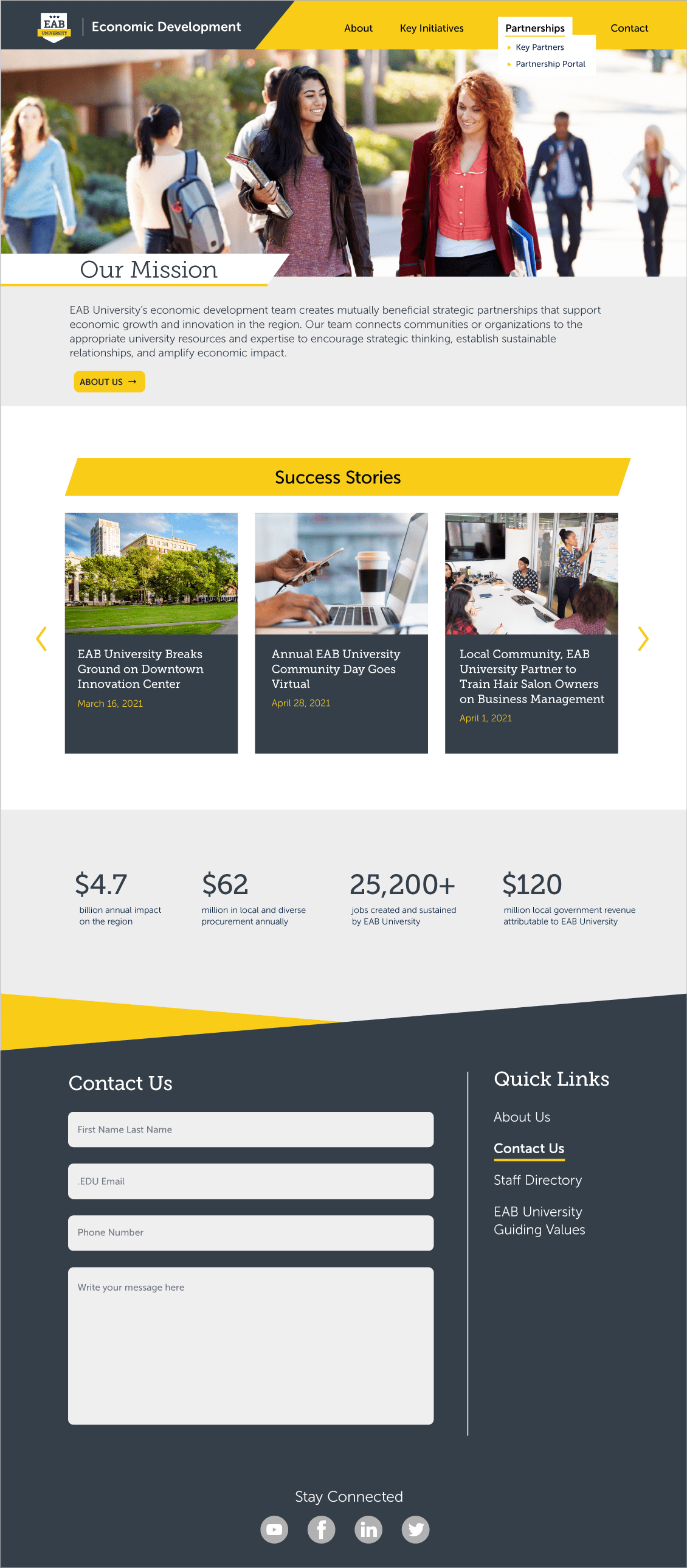10 Tips to Improve Your Economic Development Website

COVID-19 has heightened financial challenges for communities around the globe, leading higher education institutions to rethink their role in economic recovery. While inherent drivers of economic activity, institutions struggle to effectively communicate their role in economic development. A review of over 60 institutional websites revealed that many institutions do not prioritize economic development communication to internal and external stakeholders, with a large portion of schools not mentioning economic development on an institutional website.
What institutions must provide on their economic development websites
With fewer opportunities for institutions to be physically present in the community, online presence has only become more important in our virtual COVID-19 reality. Now more than ever, institutions must:
- Describe their economic development work and initiatives in a compelling way
- Publicly demonstrate their commitment to this work
- Clearly define their work to manage community expectations
- Provide a portal for engaging existing and potential partners, faculty, and other community stakeholders.
We compiled 10 essential components commonly seen among the most mature institutional economic development websites. Use these 10 components featured below on two mock webpages (including links to real institutional exemplar websites) to assess areas of strength and improvement for your current site, or to get started on building one.
Landing page example

About page example

10 components for an ideal economic development website
Profile key initiatives
Goal: Demonstrate the scope and diversity of economic development work. Highlight institutional economic development strengths.
Approaches: Group programs into categories to define key focus areas or profile specific programs integral to your institution’s work.
Case Studies:
- Virginia Tech – “Our Projects” divides programs into four categories
- University of Virginia – “Key Initiatives” page
- Drexel University – “Centers and Initiatives” page
Articulate mission
Goal: Clearly define institution’s economic development vision and purpose. This can allow your institution to get ahead of economic development (mis)-perceptions in the community.
Approaches: Explain how those working on economic development can help website visitors or clearly define your institution’s multi-faceted role in economic development.
Case Studies:
- Marquette University – statement defines purpose and encourages visitors to contact
- University of Kentucky – description with detailed engagement areas
- University of Virginia – five roles in economic development
Integrate pictures and/or videos
Goal: Ensure site is aesthetically pleasing to boost stakeholder engagement.
Approaches: Use pictures and/or videos to draw visitors into economic development information and promote page exploration.
Cast Studies:
- North Carolina State University – pictures throughout, podcast
- University of Virginia – header video
Highlight success stories
Goal: Demonstrate how the institution actually puts goals into action.
Approaches: Create a section dedicated to success stories or recent news stories, or a page detailing current partnerships.
Case Studies:
- University of Nevada, Las Vegas – “Success Stories” section and “Our Partners” page to showcase current partnerships
- Cerritos College – “Client Testimonials” page
- Virginia Tech – “News” page
Feature high-level impact statistics
Goal: Provide an easily digestible snapshot of economic impact and importance.
Approaches: Present high-level impact statistics (e.g., jobs created, annual impact on state, works published) in an obvious location on the homepage or across the bottom of all website pages.
Case Studies:
- University of Virginia – three statistics on homepage
- University of Arkansas – rotating banner across all pages
Provide contact information or contact form and staff
Goal: Allow stakeholders to reach out, engage, and ask questions.
Approaches: Use a “Contact Us” call-to-action and a staff directory so that website visitors can appropriately reach out.
Case Studies:
- Marquette University – “Contact Us” and “Office of Economic Engagement Staff” tabs under About section
- University of Nevada, Las Vegas – “Contact” page describes multiple ways to engage and links to “Staff Directory”
Allow access to/from institutional homepage
Goal: Prioritize economic development information accessibility to encourage stakeholder viewing.
Approaches: Provide a noticeable link to economic development information on the main university homepage and allow visitors to navigate back to the homepage after selecting the link.
Case Studies:
- Lanier Technical College – “Economic Development” is a main tab on the university homepage
- Iowa State University – “For Business/Industry” tab on university homepage directs to website with economic development information
- Georgetown University – website links back to main university homepage
Present an economic development strategy/framework
Goal: Connect the dots for stakeholders. Allow stakeholders to place themselves within the institution’s economic development narrative.
Approaches: Divide your website with separate tabs dedicated to areas of focus to develop a framework for visitor exploration or present visitors with a complete economic development strategy.
Case Studies:
- University of Arkansas – website tabs divided by focus area
- University of Virginia – “Economic Development Strategy” and Strategy Map one-pager
Link to economic impact study, industry portal, and economic development strategic plan
Please note, this may not be applicable in all situations.
Goal: Build connections between all economic development information to improve usability.
Approaches: Include direct links to your institution’s economic impact report, economic development strategic plan, and/or industry or partnership portal within the economic development webpage.
Case Studies:
- University of Virginia – “Measuring Impact” page links to full economic impact report
- North Carolina State University – links to “Partnership Portal” via “Partnerships” tab
- Youngstown State University – links to Economic Development Strategic Plan (EDSP) in tool bar
Link to economic development-specific social media
Goal: Encourage continued engagement from community and current and future partners on additional platforms.
Approaches: Link directly to other economic development-specific social media platforms (e.g., Twitter, Facebook), or embed social media feeds within the economic development webpage.
Case Studies:
- Cerritos College – links to Twitter, Facebook, LinkedIn
- University of Arkansas – embedded Twitter feed
This resource requires EAB partnership access to view.
Access the tool
Learn how you can get access to this resource as well as hands-on support from our experts through Strategic Advisory Services.
Learn More